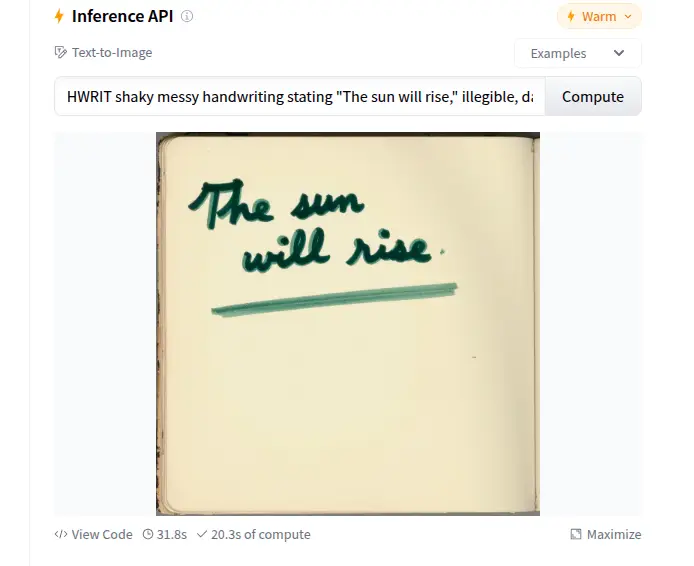Flux Handwriting Model: AI Mimicing Human Handwriting
This article explores the capabilities of Flux models, specifically the fofr/flux-handwriting model, for generating images of handwritten text. It details how to use this model via Hugging Face and its Inference API, showcasing its ability to create realistic-looking handwritten images from text prompts. The article then goes further, demonstrating the creation of a simple storytelling application that combines the fofr/flux-handwriting model with Google's Gemini LLM to generate a short story and then create a series of handwritten images illustrating its parts.
Flux Models and Handwriting Generation
Flux models are generative AI models capable of producing high-quality images and other media. The fofr/flux-handwriting model is a fine-tuned version specializing in generating images of handwritten text. The article explains how to access and use this model via two main methods:
-
Hugging Face: Direct access through the Hugging Face model page, utilizing the
diffuserslibrary or the Inference API. The article provides code examples demonstrating both approaches. Crucially, the prompt must include "HWRIT handwriting" to trigger the desired effect. -
Replicate: An alternative platform for running the model, although it incurs a cost per run.
Example Prompts and Outputs
The article includes examples of prompts and their corresponding outputs, highlighting the model's ability to interpret stylistic details such as handwriting style ("shaky," "messy"), ink color, and paper texture. Images are displayed to visually demonstrate the results.
Storytelling Application
The core innovation of this article is the creation of a storytelling application. This application leverages the Gemini LLM to generate a short story and then divides it into seven segments. Each segment is used as a prompt for the fofr/flux-handwriting model, generating seven handwritten images. These images are then combined using OpenCV to create a short video, effectively illustrating the story. The article provides the code for this application, including installation instructions and explanations of each step. Note that the code includes a delay to avoid exceeding API request limits.
Conclusion and FAQs
The article concludes by summarizing the potential of Flux models for creative applications and answers frequently asked questions about the fofr/flux-handwriting model, including its usage with the diffusers library and alternative access methods.




The provided images remain in their original .webp format. Note that the image paths are relative and would need to be adjusted depending on the actual file location.
The above is the detailed content of Flux Handwriting Model: AI Mimicing Human Handwriting. For more information, please follow other related articles on the PHP Chinese website!

Hot AI Tools

Undresser.AI Undress
AI-powered app for creating realistic nude photos

AI Clothes Remover
Online AI tool for removing clothes from photos.

Undress AI Tool
Undress images for free

Clothoff.io
AI clothes remover

Video Face Swap
Swap faces in any video effortlessly with our completely free AI face swap tool!

Hot Article

Hot Tools

Notepad++7.3.1
Easy-to-use and free code editor

SublimeText3 Chinese version
Chinese version, very easy to use

Zend Studio 13.0.1
Powerful PHP integrated development environment

Dreamweaver CS6
Visual web development tools

SublimeText3 Mac version
God-level code editing software (SublimeText3)

Hot Topics
 Best AI Art Generators (Free & Paid) for Creative Projects
Apr 02, 2025 pm 06:10 PM
Best AI Art Generators (Free & Paid) for Creative Projects
Apr 02, 2025 pm 06:10 PM
The article reviews top AI art generators, discussing their features, suitability for creative projects, and value. It highlights Midjourney as the best value for professionals and recommends DALL-E 2 for high-quality, customizable art.
 Getting Started With Meta Llama 3.2 - Analytics Vidhya
Apr 11, 2025 pm 12:04 PM
Getting Started With Meta Llama 3.2 - Analytics Vidhya
Apr 11, 2025 pm 12:04 PM
Meta's Llama 3.2: A Leap Forward in Multimodal and Mobile AI Meta recently unveiled Llama 3.2, a significant advancement in AI featuring powerful vision capabilities and lightweight text models optimized for mobile devices. Building on the success o
 Best AI Chatbots Compared (ChatGPT, Gemini, Claude & More)
Apr 02, 2025 pm 06:09 PM
Best AI Chatbots Compared (ChatGPT, Gemini, Claude & More)
Apr 02, 2025 pm 06:09 PM
The article compares top AI chatbots like ChatGPT, Gemini, and Claude, focusing on their unique features, customization options, and performance in natural language processing and reliability.
 Is ChatGPT 4 O available?
Mar 28, 2025 pm 05:29 PM
Is ChatGPT 4 O available?
Mar 28, 2025 pm 05:29 PM
ChatGPT 4 is currently available and widely used, demonstrating significant improvements in understanding context and generating coherent responses compared to its predecessors like ChatGPT 3.5. Future developments may include more personalized interactions and real-time data processing capabilities, further enhancing its potential for various applications.
 Top AI Writing Assistants to Boost Your Content Creation
Apr 02, 2025 pm 06:11 PM
Top AI Writing Assistants to Boost Your Content Creation
Apr 02, 2025 pm 06:11 PM
The article discusses top AI writing assistants like Grammarly, Jasper, Copy.ai, Writesonic, and Rytr, focusing on their unique features for content creation. It argues that Jasper excels in SEO optimization, while AI tools help maintain tone consist
 Choosing the Best AI Voice Generator: Top Options Reviewed
Apr 02, 2025 pm 06:12 PM
Choosing the Best AI Voice Generator: Top Options Reviewed
Apr 02, 2025 pm 06:12 PM
The article reviews top AI voice generators like Google Cloud, Amazon Polly, Microsoft Azure, IBM Watson, and Descript, focusing on their features, voice quality, and suitability for different needs.
 Top 7 Agentic RAG System to Build AI Agents
Mar 31, 2025 pm 04:25 PM
Top 7 Agentic RAG System to Build AI Agents
Mar 31, 2025 pm 04:25 PM
2024 witnessed a shift from simply using LLMs for content generation to understanding their inner workings. This exploration led to the discovery of AI Agents – autonomous systems handling tasks and decisions with minimal human intervention. Buildin
 AV Bytes: Meta's Llama 3.2, Google's Gemini 1.5, and More
Apr 11, 2025 pm 12:01 PM
AV Bytes: Meta's Llama 3.2, Google's Gemini 1.5, and More
Apr 11, 2025 pm 12:01 PM
This week's AI landscape: A whirlwind of advancements, ethical considerations, and regulatory debates. Major players like OpenAI, Google, Meta, and Microsoft have unleashed a torrent of updates, from groundbreaking new models to crucial shifts in le






